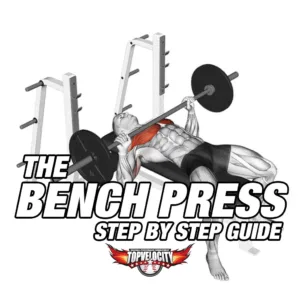 The bench press is a cornerstone exercise, renowned for building upper body strength, particularly in the chest, shoulders, and triceps. It's a staple for athletes, especially in the baseball community, where power and stability are paramount. Whether you're a beginner looking to incorporate the bench press into your routine or an experienced lifter aiming for optimal performance, this comprehensive guide, grounded in evidence-based practice, will steer you through the nuances of the bench press technique.
The bench press is a cornerstone exercise, renowned for building upper body strength, particularly in the chest, shoulders, and triceps. It's a staple for athletes, especially in the baseball community, where power and stability are paramount. Whether you're a beginner looking to incorporate the bench press into your routine or an experienced lifter aiming for optimal performance, this comprehensive guide, grounded in evidence-based practice, will steer you through the nuances of the bench press technique.
Before diving into the mechanics of the bench press, it's essential to recognize its importance in athletic development. The bench press isn't just about brute strength; it's about controlled power, stability, and precision – qualities that define an elite athlete. This compound movement engages multiple muscle groups, contributing to a stronger, more balanced physique (Clark, Lucett, & McGill, 2008).
Getting Started: Bench Press Setup and Safety
- Positioning: Lie flat on the bench with your eyes directly under the bar. Plant your feet firmly on the ground, ensuring stability throughout the exercise.
- Grip: Grasp the barbell with a grip slightly wider than shoulder-width. Wrists should be straight, not bent, to support the weight effectively (Barnett, Kippers, & Turner, 1995).
- Unracking: With a braced core and a tight grip, lift the bar from the rack, locking your arms above your chest (McGill, McDermott, & Fenwick, 2009).
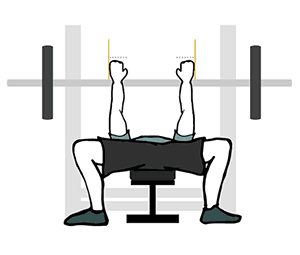
The Bench Press Movement: Step by Step
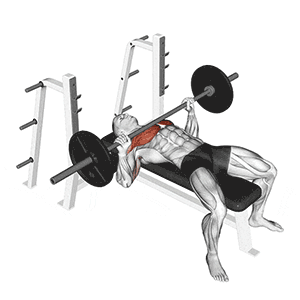
The Bench Press Descent
- Breath: Take a deep breath and hold it to keep your ribcage expanded and spine neutral (Schoenfeld & Contreras, 2016).
- Bar Path: Lower the bar in a controlled manner, aiming to touch the mid-chest area (Clemons & Aaron, 1997).
- Elbow Alignment: Keep elbows at a 45-degree angle from your body to reduce shoulder strain (Lehman, 2005).
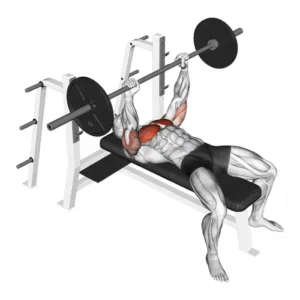
(Visual guide showcasing the descent phase of the bench press with correct elbow alignment.)
The Bench Press Press
- Drive: Push the bar up and away from the chest, exhaling as you go. Focus on driving through your feet and engaging your core for maximum power (Madsen & McLaughlin, 1984).
- Lockout: Extend your arms fully at the top of the lift without losing shoulder stability (Welsch, Bird, & Mayhew, 2005).
- Repeat: Reset your breath at the top and perform the next rep with the same controlled motion.
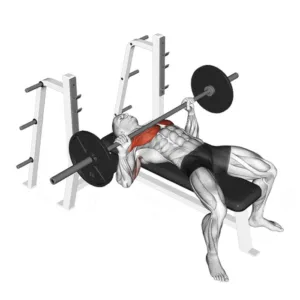
(Illustration demonstrating the correct execution of the pressing phase of the bench press.)
Refining Your Technique
- Consistency: Practice the lift with light weights until the movement pattern becomes second nature (Fleck & Kraemer, 2014).
- Progressive Overload: Gradually increase the weight as your strength improves, adhering to proper form to prevent injury (Kraemer & Ratamess, 2004).
- Spotter Usage: Always have a spotter, especially when lifting heavy or near max capacity for safety and confidence (Kraemer & Ratamess, 2004).
- Arching the Back: Maintain a slight, natural arch in your lower back, but avoid excessive arching, which can put undue stress on the spine (McGill, 2001).
- Bouncing the Bar: Touch your chest gently with the bar without bouncing; this ensures muscle engagement and reduces momentum (Schoenfeld, 2010).
- Flaring Elbows: Keep elbows tucked to protect your shoulders and improve the efficiency of the lift (Glass & Armstrong, 1997).
Setting Bench Press Goals: What Weights to Target
- Starting Off: Bench Press Benchmarks for Beginners For those just embarking on their strength training journey, hitting a 103 lb bench press (1RM – one-rep maximum) is a solid goal to aim for. This benchmark is not just a starting point; it's a commendable achievement that sets you apart from the general population.
- Progressing to Intermediate Levels: Up the Ante As you progress beyond the basics, the intermediate milestone to strive for is a 217 lb bench press (1RM). Achieving this level signifies that you've reached a notable degree of strength, placing you well within the intermediate category according to Strength Level standards – a mark of true lifting prowess.
- Understanding the Averages: Where Do You Stand? The bench press, a quintessential measure of upper body strength, sees an average lift of 217 lb (1RM) for male athletes. Attaining or surpassing this average puts you in the intermediate strength bracket, showcasing a significant lifting capability.
- Defining a 'Good' Bench Press: Setting the Standard What constitutes a 'good' bench press? For male novices, pressing 103 lb (1RM) is not only a realistic target but also an impressive one in the broader scope of strength levels. It's a commendable lift that demonstrates dedication and marks the first milestone in your strength development.
Male Bench Press Standards (lb)
The Bench Press by Age
The Bench Press by Bodyweight
Frequently Asked Questions about Pitching Velocity and Training
Q: What is TopVelocity? A: TopVelocity is a comprehensive baseball training program designed to enhance a player's natural abilities and reduce the risk of injury. It includes the 3X Pitching Velocity Program, among others, aimed at helping pitchers increase their throwing speed safely and effectively.
Q: Who created the TopVelocity programs? A: The TopVelocity programs were developed by Brent Pourciau, a retired professional pitcher with a master’s degree in kinesiology and a Ph.D. candidate in Sports Science at Liberty University.
Q: Can the TopVelocity programs help players who have had injuries? A: Yes. The programs were created with a deep understanding of overcoming injuries, particularly those related to pitching. They are designed to help players recover and improve their performance post-injury while minimizing the risk of future injuries.
Q: How does the 3X Pitching Velocity Program work? A: The 3X Pitching Velocity Program uses science-backed methods to increase pitching speed. It focuses on biomechanics, functional strength training, and proper throwing techniques to help pitchers gain velocity without compromising their arm health.
Q: Is the TopVelocity training suitable for all ages? A: While TopVelocity programs can be beneficial for a wide range of ages, they are especially effective for players who are physically mature and have a basic level of conditioning. It’s recommended that young players and their parents consult with a coach or a training professional to determine the appropriate program for their age and skill level.
Q: How long does it take to see results with TopVelocity programs? A: The time it takes to see results can vary based on the individual’s dedication to the program, their initial skill level, and their physical condition. Consistency and proper adherence to the program’s guidelines are key for the best results.
Q: Can catchers and position players also benefit from TopVelocity programs? A: Yes, there are specific programs designed for position players and catchers, like the 2X Velocity Program for Position Players and the 2X Sub 2.0 Poptime Program for Catchers, that focus on improving their respective skill sets.
Q: Are the training methods used in TopVelocity evidence-based? A: Yes, TopVelocity programs are developed based on evidence-based practices. Brent Pourciau has leveraged his academic background and personal experience to create programs that are both scientifically grounded and proven effective in the field.
Q: Where can I find TopVelocity programs? A: TopVelocity programs are available online through the official TopVelocity website. They offer a variety of resources, including training videos, manuals, and support from trained professionals.
Q: What kind of support does TopVelocity provide? A: TopVelocity offers a range of support options, including access to coaches, online forums, and customer service to assist with any questions or concerns regarding the programs.
For more exclusive content check out the TopVelocity Patreon Pro!
References
Barnett, C., Kippers, V., & Turner, P. (1995). Effects of variations of the bench press exercise on the EMG activity of five shoulder muscles. The Journal of Strength & Conditioning Research, 9(4), 222-227.
Clark, M. A., Lucett, S., & Corn, R. J. (2008). NASM essentials of personal fitness training. Lippincott Williams & Wilkins.
Clemons, J. M., & Aaron, C. (1997). Effect of grip width on the myoelectric activity of the prime movers in the bench press. The Journal of Strength & Conditioning Research, 11(2), 82-87.
Fleck, S. J., & Kraemer, W. (2014). Designing resistance training programs, 4E. Human Kinetics.
Glass, S. C., & Armstrong, T. (1997). Electromyographical activity of the pectoralis muscle during incline and decline bench presses. The Journal of Strength & Conditioning Research, 11(3), 163-167.
Kraemer, W. J., & Ratamess, N. A. (2004). Fundamentals of resistance training: Progression and exercise prescription. Medicine and Science in Sports and Exercise, 36(4), 674-688.
Lehman, G. J. (2005). The influence of grip width and forearm pronation/supination on upper-body myoelectric activity during the flat bench press. The Journal of Strength & Conditioning Research, 19(3), 587-591.
Madsen, N., & McLaughlin, T. (1984). Kinematic factors influencing performance and injury risk in the bench press exercise. Medicine and Science in Sports and Exercise, 16(4), 376-381.
McGill, S. M. (2001). Low back stability: From formal description to issues for performance and rehabilitation. Exercise and Sport Sciences Reviews, 29(1), 26-31.
McGill, S. M., McDermott, A., & Fenwick, C. M. (2009). Comparison of different strongman events: trunk muscle activation and lumbar spine motion, load, and stiffness. The Journal of Strength & Conditioning Research, 23(4), 1148-1161.
Schoenfeld, B. (2010). The mechanisms of muscle hypertrophy and their application to resistance training. Journal of Strength and Conditioning Research, 24(10), 2857-2872.
Schoenfeld, B. J., & Contreras, B. (2016). Attentional focus for maximizing muscle development: The mind-muscle connection. Strength & Conditioning Journal, 38(1), 27-29. https://www.researchgate.net/profile/Brad-Schoenfeld/publication/291018876_Attentional_Focus_for_Maximizing_Muscle_Development/links/56aff17908ae9f0ff7b295ce/Attentional-Focus-for-Maximizing-Muscle-Development.pdf
Welsch, E. A., Bird, M., & Mayhew, J. L. (2005). Electromyographic activity of the pectoralis major and anterior deltoid muscles during three upper-body lifts. Journal of Strength and Conditioning Research, 19(2), 449-452.



